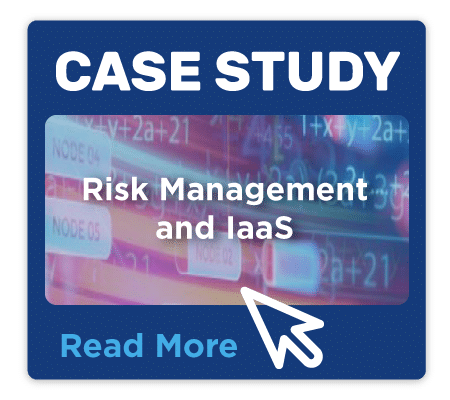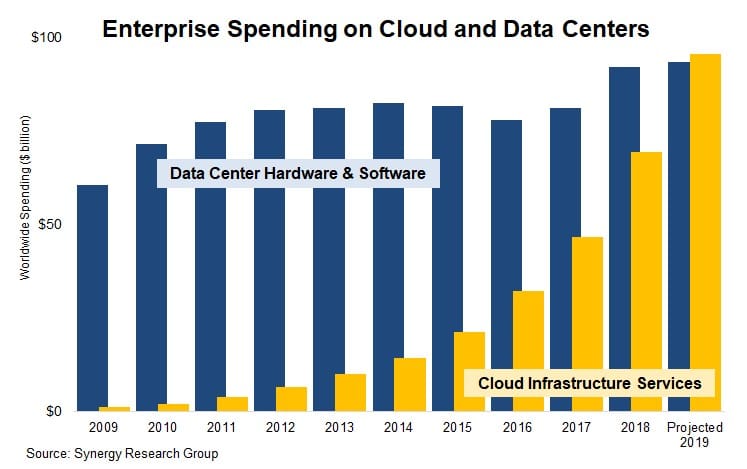Getting Started with Infrastructure as a Service
Infrastructure as a Service (IaaS) has cloud benefits such as scalability, speed, and hands-off management, leading companies to double their budget spent on IaaS over the last two years.
This growing as-a-service offering gives IT teams a manageable entry point to the cloud since it allows companies to offload certain data or technology sets they feel comfortable with while keeping others on premises.
Table of Contents

Current Landscape of Infrastructure as a Service
If there’s one point that exemplifies the rapid adoption of IaaS, it’s the fact that spending on the cloud has exploded over the last decade, while the budget reserved for data centers has remained nearly stagnant. In fact, according to Synergy Research Group, 2019 marked the first year that companies spent more on cloud services than on equipment for data centers.
In the words of John Dinsdale, chief analyst and research director at Synergy Research Group, “It has taken just eight quarters for the public IaaS and PaaS markets to double in size, and our forecast shows them doubling in size again over the next eleven quarters.”
Think about that for a second. Market spend on as-a-service technology offerings is predicted to double in size again over the next two years.
Where does your organization fit into this picture? Have you already embraced a cloud-based IT model? Or are you still figuring out what’s right for your business? Read on to learn what IaaS is, why it has IT teams fawning, and how to ensure your IaaS provider brings their A-game to the partnership.
What is IaaS?
Infrastructure as a service (IaaS) is computing, storage, desktop and networking resources delivered on demand.

With IaaS, businesses continue to manage their own applications, data and software. The IaaS provider manages the servers, hard drives and networks. This divide in responsibility helps companies retain control over their IT environment while transitioning to a hybrid cloud model.
IaaS boasts benefits like flexibility, scalability, maintenance, and speed. These benefits continue to drive adoption, which shows no signs of slowing down anytime soon.
Infrastructure as a Service Benefits and Best Practices for Mid-Size and Enterprise Companies
IaaS helps teams embrace cloud solutions without going fully virtual. A 2020 survey from Security Boulevard reported the top three priorities for IT leaders in government are:
- Cybersecurity and data loss prevention (93%)
- Innovation and application technologies (68%)
- Modernization of outdated IT systems and applications (55%)
The benefits of IaaS are in line with those of any cloud solution—instant scalability, flexibility with services, predictable cost, access to top tier tech and support, etc. The main differentiator is that IaaS allows IT teams to retain control over portions of their IT environment. This balance in responsibility makes moving to the cloud more palatable for companies that may be apprehensive. Below are the top benefits of infrastructure as a service.
 1. IaaS reduces refresh cost on hardware and infrastructure
1. IaaS reduces refresh cost on hardware and infrastructure
Simply put, IaaS eliminates the capital investment required for hardware purchases. It also eliminates the associated costs of maintaining infrastructure, such as paying for the physical space, the utility costs, and the staff time to maintain it. Another bonus is the subscription model of IaaS spreads the necessary purchases into consistent monthly bills that allow predictability.
 3. Experience flexibility in services with IaaS
3. Experience flexibility in services with IaaS
One of the most important features of IaaS is the ability to scale up as well as down, ensuring that you aren’t paying for resources that are not being used.
Rapid response. On demand. These aren’t terms typically associated with major IT infrastructure enhancements. Yet with IaaS, this is the reality.
It’s simply a matter of changing your cloud server allocation. IT teams can now pull together entire computing platforms at a lightning fast speed so you can quickly adapt to changing market needs.
 5. IaaS makes cutting-edge technology affordable
5. IaaS makes cutting-edge technology affordable
Given the costs of traditional, on-premise server infrastructure hardware, it is simply not feasible for most businesses—particularly SMBs—to keep up with the newest and latest technology. For IaaS providers, offering the latest technology is standard operating procedure and a competitive necessity. By choosing Infrastructure as a service, that competitive advantage gets passed to you.
 7. IaaS opens the door to top-tier security features
7. IaaS opens the door to top-tier security features
Perhaps the single most significant benefit of IaaS is the advanced security technology. Cybersecurity and data protection are high on the list of concerns for IT leaders, according to the World Economic Forum’s Global Risks Report. Cyberthreats are growing, and every business from government to financial services to healthcare can fall victim.
IaaS eases the concern of cyberattacks because of its advanced security and physical protection of IT infrastructure with built-in redundancies. IT providers build their business models around the security of their own IT infrastructure and assets, so state-of-the-art security gets passed along to clients when they use IaaS. Security and compliance are of the utmost importance when evaluating cloud options. This case study shows how a risk management company put security and compliance first with IaaS.
 2. Hassle-free scalability across divisions
2. Hassle-free scalability across divisions
With the ability to offer on-demand resources, IaaS can transform the way an organization grows and changes. It shares investments across multiple business units, so the whole organization gets what it needs in real time.
Unveiling a new initiative? No problem.
Doubling your workforce as a result of seasonal demand? Let’s do it.
Your IT department can easily tackle these challenges when they don’t need to focus on procurement, setup, configuration, and testing a new IT infrastructure. With IaaS, IT teams can manage desktop resources, storage systems, servers, and networks from a central console with access to support from their IaaS provider as needed.
 4. IaaS focuses on strategic innovation by reducing monotonous tasks
4. IaaS focuses on strategic innovation by reducing monotonous tasks
In house IT is struggling more and more to keep up with maintaining infrastructure hardware while finding the time to create business innovation and speed to market. IaaS provides cost-effective and efficient IT maintenance and operation, so you can offload manual processes like patches, upgrades, and repairs, giving your team more time to focus on business needs. This shift in providing more challenging, strategy-driven work is also a smart way to attract and keep top IT talent.
 6. Gain on-demand access and availability with IaaS
6. Gain on-demand access and availability with IaaS
When disaster strikes, your business will be up and running thanks to IaaS. Cloud-based infrastructure provides access anywhere, anytime. So even if your office location isn’t accessible, your valuable corporate data still will be. As long as you have an internet connection, IaaS keeps your business running full steam ahead.
 8. IaaS is tailored to your IT requirements to ensure compliance
8. IaaS is tailored to your IT requirements to ensure compliance
One of the key advantages with cloud services is that compliance for your data is less of a lift. IT solutions companies can provide guidance on compliance standards so you can rest assured your IT environment will meet the specific compliance requirements of your business.
You may have noticed a trend here. One of the main reasons that cloud services are revolutionizing IT is that they ultimately make your job easier. By reducing worries about maintenance tasks, security concerns and aging equipment, IaaS can turn sleepless nights into restful evenings.
What’s more, with added layers of flexibility and access to advanced technology, your team can finally turn into the innovation center your organization has been searching for. The key is to choose the provider best suited to your company’s unique challenges.
What to Know before Choosing an Infrastructure as a Service Provider
The right IaaS provider will allow you to focus on your business needs instead of spending the time and money it takes to plan, procure, secure, and manage the right infrastructure to meet your application demands. Choosing a strategic IaaS provider can mean the difference between success and failure for your team.
5 Questions to Ask an IaaS Provider Before Signing on the Line
When vetting IaaS providers, it’s important to get to the right details for your business. These questions will help determine whether or not a potential vendor is right for your organization.
1. What does your data center look like?
This is the first question you ask when analyzing an IaaS provider. With this information, you’re getting insight into the security features of a vendor’s data center. You want to look for the latest and greatest, which should be table stakes for any vendor worth a partnership. Look for a provider that uses a Tier 5 Data Center, which has the ability to run forever without water and detect and protect against outside air pollutants.
3. What authentication options does your solution provide when users access systems?
IaaS providers should have appropriate measures in place to authenticate people who are trying to access the system and give specific authorization for certain permissions. Look for the ability to replicate tiered authentication systems because it protects the integrity of your system and the security of all data within it
2. How long can your infrastructure run in an outage?
Don’t settle for anything less than the best when it comes to security.
The timeframe a data center can remain up and running during a power outage is crucial knowledge.
At a minimum, the IaaS solution should provide geographically redundant options. The virtual infrastructure should also contain power sustainability and efficiency options to further improve your experience.
4. What is your maintenance protocol?
IaaS providers should be able to show regular maintenance done on the system to ensure normal hacks cannot get in through known vulnerabilities. In addition, you want to make sure they are staying on top of your environment to ensure optimal performance and prevent issues before they happen.
5. Is support available outside of business hours?
Support. Your business is unique, and so is the support you need. Service-level agreements define the level of service you’ll receive from IaaS providers, so pay careful attention to the expectations outlined in these. For most companies, business happens outside of business hours, so support needs to be available 24 hours a day, seven days a week. Make sure to find a provider you can rely on when you need them, not one who will keep you waiting in line.
The right infrastructure as a service provider can help your team fully integrate IaaS with your existing cloud environment. We suggest beginning by integrating it with your existing cloud and on-premise environment. Once you feel comfortable, you can migrate more to your provider over time.
ComportSecure ensures that our team walks beside yours to provide the hand-on service that’s expected with IaaS. Want to learn more? Let’s connect and discuss. ComportSecure provides a complete suite of IaaS and Managed Infrastructure services to modernize your IT environment.
Author: Bill Flatley, Field CTO for Healthcare
Bill is responsible for technical strategies and recommendations for Comport’s Healthcare clients. His extensive experience includes four healthcare systems in leadership roles supporting Clinical Applications, Digital Health, and Office of the CIO as the primary liaison between IT and the business.






























